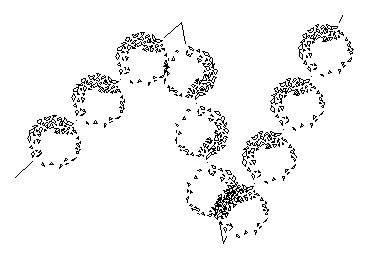LINETYPE Command in AutoCAD
linetypes are loaded, set, and modified.

Find
It displays the Linetype Manager.
Options are shown when you use -LINETYPE at the Command prompt.
linetypes are loaded, set, and modified at the command prompt.
The following questions are shown.
Linetypes List
shows the dialogue window for selecting a linetype file (a standard file selection dialogue box). The linetypes that are present in a LIN file are presented once it has been selected.
Create
a new linetype is created and saved in a LIN file.
It displays the Create or Append Linetype File dialogue box, which is a typical file selection dialogue box. Indicate the file to which the linetype should be added.
With LINETYPE, complicated linetypes cannot be created. (This does not apply to AutoCAD LT.)
Detailed Text
A linetype description of up to 47 characters may be entered. A remark or a string of underscores, dots, dashes, and spaces can be used as the explanation to display a quick illustration of the linetype pattern.
Linetype Design
Enter a pattern definition as a list of integers with commas between them. For dash lengths, enter positive numbers, and for space lengths, enter negative values. Put a zero in place of a dot.

The pattern alignment used at the endpoints of distinct lines, circles, and arcs is indicated by the letter "A" in the pattern defining prompt. It only supports alignment of the A-type.
A-type alignment ensures that all lines and arcs begin and end with dashes. The definition automatically includes the letter A. If you want to construct a linetype in a text editor, you must start the definition with a.
You must load a linetype after generating it in order to use it.
Load
opens a file containing the definition of a linetype. Standard linetypes can be found in the following files:
- Acad.lin for AutoCAD
- acadlt.lin AutoCAD LT
A common file selection dialogue box, the Select Linetype File dialogue box, is shown. The file that contains the linetype you wish to load must be entered or chosen.
Set
It establishes the current linetype for later-drawn objects. The linetype of each item can be altered individually or by layer.
The software looks for the definition of the linetype you requested in the LIN file if it is not loaded. The software shows a notice and sends you back to the Command prompt if the linetype cannot be found.
To view a list of all loaded linetype names, type? If you enter by layer, newly created objects take on the linetype of the layer on which they were drawn. New objects are drawn using the CONTINUOUS linetype until they are grouped into a block if you enter by block. The linetype of the block is inherited by the objects each time you insert that block.
LISTENER SCALE LTSCALE
LTSCALE and PSLTSCALE, often known as linetype scaling, can be used to modify how a linetype is presented. By doing this, you may exhibit your drawings at various scales while keeping the look of the linestyles. Each line in the image has a distinct LTSCALE while using the same linetype.
LTSCALE
It regulates the overall linetype scale.
Type "LTSCALE" on the command line to alter the LTSCALE for a drawing. You'll be asked to:
Type new Linetype scale factor 1.0000 into the box:
You can provide a value for your Linetype scale.
Note: The Linetype scale should typically be matched to your drawing's scale.
Use an LTSCALE of 100 if the final design will be shown at a scale of 1:100. Use the PSLTSCALE to manage the scale of your linetypes and the LTSCALE to control the linetypes in Modelspace if you're working with numerous scales in your viewports.
Making Your Own AutoCAD Line Type
For most tasks, the standard linetypes in AutoCAD are sufficient. However, there are occasions when having it on our own is simply not enough. The issue is that might be challenging to create a bespoke linetype. But if you've had express tools set up, making bespoke linetypes may be a breeze.
Even when creating intricate objects, I enjoy using it. Compared to utilizing basic objects, it is quicker, simpler, and uses less hardware resources. Look at this thing down here.
